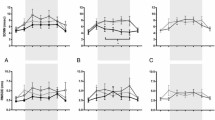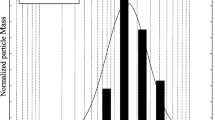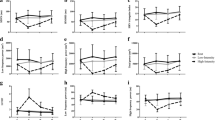Abstract
Acrolein is an irritating aldehyde generated during combustion of organic compounds. Altered autonomic activity has been documented following acrolein inhalation, possibly impacting myocardial synchrony and function. Given the ubiquitous nature of acrolein in the environment, we sought to better define the immediate and delayed functional cardiac effects of acrolein inhalation in vivo. We hypothesized that acrolein inhalation would increase markers of cardiac mechanical dysfunction, i.e., myocardial dyssynchrony and performance index in mice. Male C57Bl/6J mice were exposed to filtered air (FA) or acrolein (0.3 or 3.0 ppm) for 3 h in whole-body plethysmography chambers (n = 6). Echocardiographic analyses were performed 1 day before exposure and at 1 and 24 h post-exposure. Speckle tracking echocardiography revealed that circumferential strain delay (i.e., dyssynchrony) was increased at 1 and 24 h following exposure to 3.0 ppm, but not 0.3 ppm, when compared to pre-exposure and/or FA exposure. Pulsed wave Doppler of transmitral blood flow revealed that acrolein exposure at 0.3 ppm, but not 3.0 ppm, increased the Tei index of myocardial performance (i.e., decreased global heart performance) at 1 and 24 h post-exposure compared to pre-exposure and/or FA exposure. We conclude that short-term inhalation of acrolein can acutely modify cardiac function in vivo and that echocardiographic evaluation of myocardial synchrony and performance following exposure to other inhaled pollutants could provide broader insight into the health effects of air pollution.






Similar content being viewed by others
References
Brook, R. D., Rajagopalan, S., Pope, C. A, 3rd, Brook, J. R., Bhatnagar, A., Diez-Roux, A. V., et al. (2010). Particulate matter air pollution and cardiovascular disease: An update to the scientific statement from the American Heart Association. Circulation, 121, 2331–2378.
Moghe, A., Ghare, S., Lamoreau, B., Mohammad, M., Barve, S., McClain, C., & Joshi-Barve, S. (2015). Molecular mechanisms of acrolein toxicity: Relevance to human disease. Toxicological Sciences, 143, 242–255.
EPA. (2003). Toxicological review of acrolein (CAS No. 107-02-8). Washington, DC: US Environmental Protection Agency.
ATSDR. (2007). Toxicological profile for acrolein. U.S: Department of Health and Human Services, Public Health Service, Atlanta, GA.
Haussmann, H. J. (2012). Use of hazard indices for a theoretical evaluation of cigarette smoke composition. Chemical Research in Toxicology, 25, 794–810.
DeJarnett, N., Conklin, D. J., Riggs, D. W., Myers, J. A., O’Toole, T. E., Hamzeh, I., et al. (2014). Acrolein exposure is associated with increased cardiovascular disease risk. Journal of the American Heart Association, 3, e000934. doi:10.1161/JAHA.114.000934.
Perez, C. M., Ledbetter, A. D., Hazari, M. S., Haykal-Coates, N., Carll, A. P., Winsett, D. W., et al. (2013). Hypoxia stress test reveals exaggerated cardiovascular effects in hypertensive rats after exposure to the air pollutant acrolein. Toxicological Sciences, 132, 467–477.
Hazari, M. S., Griggs, J., Winsett, D. W., Haykal-Coates, N., Ledbetter, A., Costa, D. L., & Farraj, A. K. (2014). A single exposure to acrolein desensitizes baroreflex responsiveness and increases cardiac arrhythmias in normotensive and hypertensive rats. Cardiovascular Toxicology, 14, 52–63.
Luo, J., Hill, B. G., Gu, Y., Cai, J., Srivastava, S., Bhatnagar, A., & Prabhu, S. D. (2007). Mechanisms of acrolein-induced myocardial dysfunction: Implications for environmental and endogenous aldehyde exposure. American Journal of Physiology Heart and Circulatory Physiology, 293, H3673–H3684.
Wang, L., Sun, Y., Asahi, M., & Otsu, K. (2011). Acrolein, an environmental toxin, induces cardiomyocyte apoptosis via elevated intracellular calcium and free radicals. Cell Biochemistry and Biophysics, 61, 131–136.
Wu, Z., He, E. Y., Scott, G. I., & Ren, J. (2015). Alpha, beta-unsaturated aldehyde pollutant acrolein suppresses cardiomyocyte contractile function: Role of TRPV1 and oxidative stress. Environmental Toxicology, 30, 638–647.
Stypmann, J., Engelen, M. A., Troatz, C., Rothenburger, M., Eckardt, L., & Tiemann, K. (2009). Echocardiographic assessment of global left ventricular function in mice. Laboratory Animals, 43, 127–137.
Dandel, M., Lehmkuhl, H., Knosalla, C., Suramelashvili, N., & Hetzer, R. (2009). Strain and strain rate imaging by echocardiography—Basic concepts and clinical applicability. Current Cardiology Reviews, 5, 133–148.
Thavendiranathan, P., Poulin, F., Lim, K. D., Plana, J. C., Woo, A., & Marwick, T. H. (2014). Use of myocardial strain imaging by echocardiography for the early detection of cardiotoxicity in patients during and after cancer chemotherapy: A systematic review. Journal of the American College of Cardiology, 63, 2751–2768.
Tei, C., Ling, L. H., Hodge, D. O., Bailey, K. R., Oh, J. K., Rodeheffer, R. J., et al. (1995). New index of combined systolic and diastolic myocardial performance: A simple and reproducible measure of cardiac function—a study in normals and dilated cardiomyopathy. Journal of Cardiology, 26, 357–366.
Caro, A. C., Hankenson, F. C., & Marx, J. O. (2013). Comparison of thermoregulatory devices used during anesthesia of C57BL/6 mice and correlations between body temperature and physiologic parameters. Journal of the American Association for Laboratory Animal Science, 52, 577–583.
Jaskot, R. H., Charlet, E. G., Grose, E. C., Grady, M. A., & Roycroft, J. H. (1983). An automated analysis of glutathione peroxidase, S-transferase, and reductase activity in animal tissue. Journal of Analytical Toxicology, 7, 86–88.
Perez, C. M., Hazari, M. S., Ledbetter, A. D., Haykal-Coates, N., Carll, A. P., Cascio, W. E., et al. (2015). Acrolein inhalation alters arterial blood gases and triggers carotid body-mediated cardiovascular responses in hypertensive rats. Inhalation Toxicology, 27, 54–63.
Shen, M. J., & Zipes, D. P. (2014). Role of the autonomic nervous system in modulating cardiac arrhythmias. Circulation Research, 114, 1004–1021.
Paton, J. F., Boscan, P., Pickering, A. E., & Nalivaiko, E. (2005). The yin and yang of cardiac autonomic control: Vago-sympathetic interactions revisited. Brain Research. Brain Research Reviews, 49, 555–565.
Gimelli, A., Liga, R., Genovesi, D., Giorgetti, A., Kusch, A., & Marzullo, P. (2014). Association between left ventricular regional sympathetic denervation and mechanical dyssynchrony in phase analysis: A cardiac CZT study. European Journal of Nuclear Medicine and Molecular Imaging, 41, 946–955.
Schlack, W., Schafer, S., & Thamer, V. (1994). Left stellate ganglion block impairs left ventricular function. Anesthesia and Analgesia, 79, 1082–1088.
Schlack, W., & Thamer, V. (1996). Unilateral changes of sympathetic tone to the heart impair left ventricular function. Acta Anaesthesiologica Scandinavica, 40, 262–271.
Sequeira, I. M., Haberberger, R. V., & Kummer, W. (2005). Atrial and ventricular rat coronary arteries are differently supplied by noradrenergic, cholinergic and nitrergic, but not sensory nerve fibres. Annals of Anatomy, 187, 345–355.
Reant, P., Labrousse, L., Lafitte, S., Bordachar, P., Pillois, X., Tariosse, L., et al. (2008). Experimental validation of circumferential, longitudinal, and radial 2-dimensional strain during dobutamine stress echocardiography in ischemic conditions. Journal of the American College of Cardiology, 51, 149–157.
Winter, R., Jussila, R., Nowak, J., & Brodin, L. A. (2007). Speckle tracking echocardiography is a sensitive tool for the detection of myocardial ischemia: A pilot study from the catheterization laboratory during percutaneous coronary intervention. Journal of the American Society of Echocardiography, 20, 974–981.
Marwick, T. H. (2006). Measurement of strain and strain rate by echocardiography: Ready for prime time? Journal of the American College of Cardiology, 47, 1313–1327.
Lee, A. P., Zhang, Q., Yip, G., Fang, F., Liang, Y. J., Xie, J. M., et al. (2011). LV mechanical dyssynchrony in heart failure with preserved ejection fraction complicating acute coronary syndrome. JACC Cardiovascular Imaging, 4, 348–357.
Perez, C. M., Hazari, M. S., & Farraj, A. K. (2015). Role of autonomic reflex arcs in cardiovascular responses to air pollution exposure. Cardiovascular Toxicology, 15, 69–78.
Ghilarducci, D. P., & Tjeerdema, R. S. (1995). Fate and effects of acrolein. Reviews of Environmental Contamination and Toxicology, 144, 95–146.
Moretto, N., Volpi, G., Pastore, F., & Facchinetti, F. (2012). Acrolein effects in pulmonary cells: Relevance to chronic obstructive pulmonary disease. Annals of the New York Academy of Sciences, 1259, 39–46.
Pagel, P. S., Nijhawan, N., & Warltier, D. C. (1993). Quantitation of volatile anesthetic-induced depression of myocardial contractility using a single beat index derived from maximal ventricular power. Journal of Cardiothoracic and Vascular Anesthesia, 7, 688–695.
Hatakeyama, N., Ito, Y., & Momose, Y. (1993). Effects of sevoflurane, isoflurane, and halothane on mechanical and electrophysiologic properties of canine myocardium. Anesthesia and Analgesia, 76, 1327–1332.
Palmisano, B. W., Mehner, R. W., Stowe, D. F., Bosnjak, Z. J., & Kampine, J. P. (1994). Direct myocardial effects of halothane and isoflurane. Comparison between adult and infant rabbits. Anesthesiology, 81, 718–729.
Lairez, O., Lonjaret, L., Ruiz, S., Marchal, P., Franchitto, N., Calise, D., et al. (2013). Anesthetic regimen for cardiac function evaluation by echocardiography in mice: Comparison between ketamine, etomidate and isoflurane versus conscious state. Laboratory Animals, 47, 284–290.
Lynch, P. J., & Jaffe, C. C. (2006). Heart normal short axis section. New Haven, CT: Creative Commons.
Lynch, P. J., & Jaffe, C. C. (2006). Heart apical 4c anatomy. New Haven, CT: Creative Commons.
Acknowledgments
We would like to acknowledge John Havel for his outstanding effort generating the illustrations in Figs. 1 and 2. Judy Richards at USEPA conducted the Konelab assays on the BAL fluid samples. Finally, we would like to thank Dr. Ian Gilmour, Dr. Jan Dye, and Dr. Chris Gordon of the USEPA for their thorough review of this manuscript before submission.
Author information
Authors and Affiliations
Corresponding author
Additional information
Disclaimer: This paper has been reviewed and approved for release by the National Health and Environmental Effects Research Laboratory, U.S. Environmental Protection Agency. Approval does not signify that the contents necessarily reflect the views and policies of the U.S. Environmental Protection Agency, nor does mention of trade names or commercial products constitute endorsement or recommendation for use.
Electronic supplementary material
Below is the link to the electronic supplementary material.
Rights and permissions
About this article
Cite this article
Thompson, L.C., Ledbetter, A.D., Haykal-Coates, N. et al. Acrolein Inhalation Alters Myocardial Synchrony and Performance at and Below Exposure Concentrations that Cause Ventilatory Responses. Cardiovasc Toxicol 17, 97–108 (2017). https://doi.org/10.1007/s12012-016-9360-4
Published:
Issue Date:
DOI: https://doi.org/10.1007/s12012-016-9360-4




